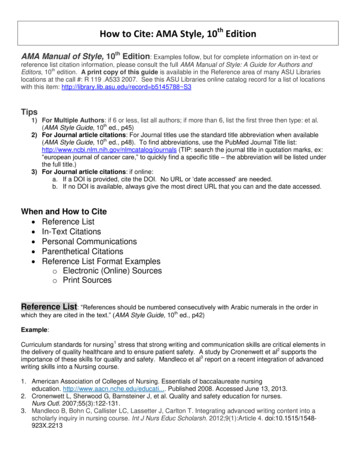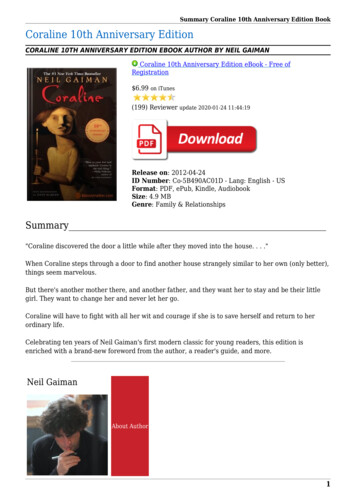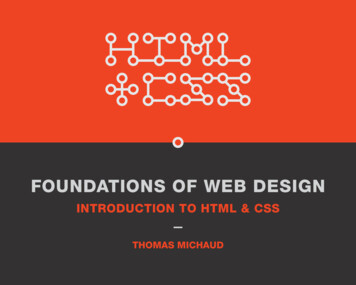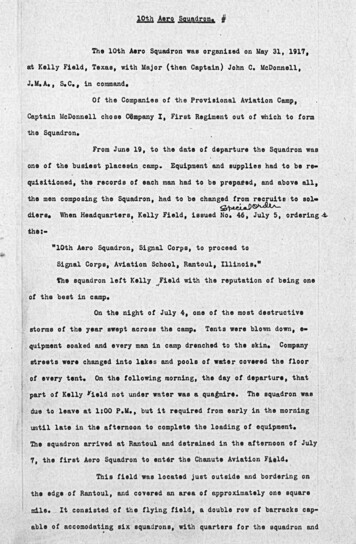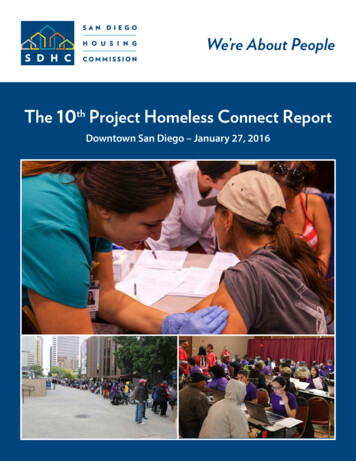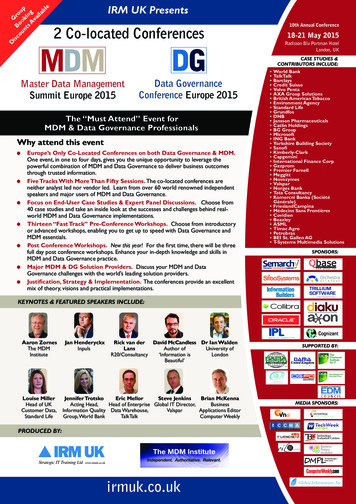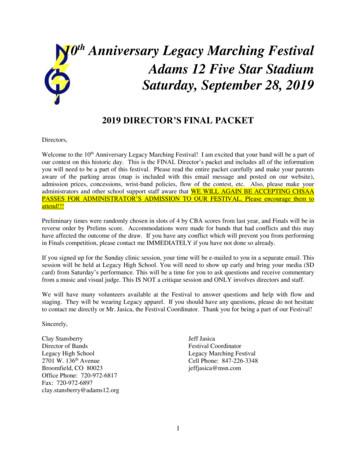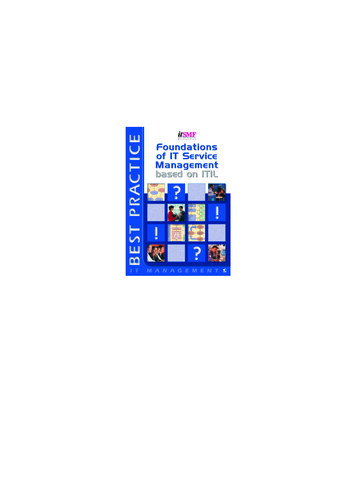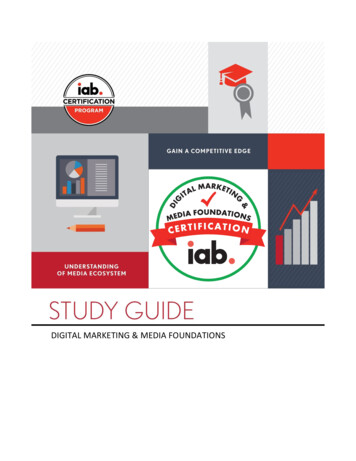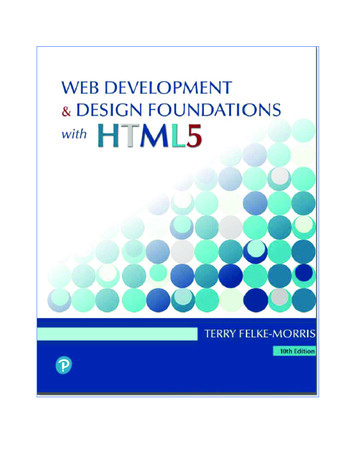
Transcription
10th EditionWeb Developmentand DesignFoundations withHTML5Terry Ann Felke-Morris, Ed.D.Professor EmeritaHarper College330 Hudson Street, NY NY 10013A01 FELK9996 10 SE FM.indd 318/09/19 5:26 PM
PrefaceWeb Development and Design Foundations with HTML5 is intended for use in a beginning web development course. This textbook introduces HTML and CSS topics such astext configuration, color configuration, and page layout, with an enhanced focus on thetopics of design, accessibility, and Web standards. The text covers the basics that webdevelopers need to build a foundation of skills: Internet concepts Creating web pages with HTML5 Configuring text, color, and page layout with Cascading Style Sheets (CSS),including the new CSS Flexbox and CSS Grid Layout Systems Web design best practices Accessibility standards The web development process Using media and interactivity on web pages Website promotion and search engine optimization E-commerce and the Web JavaScriptA special feature of this text is the Web Developer’s Handbook, which is a collection ofappendixes that provide resources including an HTML5 Reference, Special EntityCharacter List, CSS Property Reference, WCAG 2.1 Quick Reference, FTP Tutorial, andweb-safe color palette.New to This EditionBuilding on this textbook’s successful ninth edition, new features for the tenth editioninclude the following: Updated coverage of HTML5 elements and attributes Updated code samples, case studies, and web resources Expanded treatment of page layout design and responsive web design techniques Chapter 7 has been renamed Responsive Page Layout, takes a mobile firstapproach, and has an expanded focus on new layout systems including CSSFlexible Layout Module (Flexbox) and CSS Grid Layout Form layout with the CSS Flexbox and Grid Layout Systems Updated reference sections for HTML5 and CSS Additional Hands-On Practice exercisesA01 FELK9996 10 SE FM.indd 518/09/19 5:26 PM
viPrefaceStudent files are available for download from the companion website for this textbookat www.pearson.com/felke-morris. These files include solutions to the Hands-OnPractice exercises, the Website Case Study starter files, and access to the book’scompanion VideoNotes. See the access card in the front of this textbook for furtherinstructions.Organization of the TextThis textbook is designed to be used in a flexible manner; it can easily be adapted to suita variety of course and student needs. Chapter 1 provides introductory material, whichmay be skipped or covered, depending on the background of the students. Chapters 2through 4 introduce HTML and CSS coding. Chapter 5 discusses web design bestpractices and can be covered anytime after Chapter 3 (or even along with Chapter 3).Chapters 6 through 9 continue with HTML and CSS.Any of the following chapters may be skipped or assigned as independent study,depending on time constraints and student needs: Chapter 10 (Web Development),Chapter 11 (Web Multimedia and Interactivity), Chapter 12 (E-Commerce Overview),Chapter 13 (Web Promotion), and Chapter 14 (A Brief Look at JavaScript and jQuery).A chapter dependency chart is shown in Figure P.1.Figure P.1 This textbook isflexible and can be adapted toindividual needsBrief Overview of Each ChapterChapter 1: Introduction to the Internet and World Wide Web Thisbrief introduction covers the terms and concepts related to the Internet and the Webwith which Web developers need to be familiar. For many students, some of this will bea review. Chapter 1 provides the base of knowledge on which the rest of the textbookis built.A01 FELK9996 10 SE FM.indd 618/09/19 5:26 PM
PrefaceviiChapter 2: HTML Basics As HTML5 is introduced, examples and exercisesencourage students to create sample pages and gain useful experience. Students use avariety of structural, grouping, and text-level HTML elements to create web pages withhyperlinks. Solution pages for the Hands-On Practice are available in the student files.Chapter 3: Configuring Color and Text with CSSThe technique of usingCascading Style Sheets to configure the color and text on web pages is introduced. Students are encouraged to create sample pages as they read through the text. Solutions forthe Hands-On Practice are available in the student files.Chapter 4: Visual Elements and GraphicsThis chapter discusses the use ofgraphics and visual effects on web pages, including image optimization, CSS borders, CSSimage backgrounds, CSS visual effects, and HTML5 visual elements. Students are encouraged to create web pages as they read through the text. Sample solutions for the HandsOn Practice are available in the student files.Chapter 5: Web DesignThis chapter focuses on recommended web designpractices and accessibility. Some of this is reinforcement because tips about recommended website design practices are incorporated into the other chapters.Chapter 6: Page LayoutThis chapter has been greatly revised for the 10th ediition. Itcontinues the study of CSS begun earlier and introduces techniques for positioning and floating web page elements, including CSS two-column page layouts. Coding techniques for CSSsprites, configuring for print, a fixed position navigation bar, a single page website, and parallax scrolling are also introduced. Students are encouraged to create web pages as they readthrough the text. Sample solutions for the Hands-On Practice are available in the student files.Chapter 7: Responsive Page LayoutThis chapter has undergone a huge revision for the 10th edition. Chapter 7 has increased in-depth coverage of CSS Flexible BoxLayout (Flexbox) and CSS Grid Layout. Chapter 7 continues to introduce CSS media queriesand responsive image techniques along with CSS feature queries. Students are encouragedto create pages as they read through the text. Sample solutions for the Hands-On Practiceare available in the student files.Chapter 8: TablesThis chapter focuses on the HTML elements used to createtables. Methods for configuring a table with CSS are introduced. Students are encouragedto create pages as they read through the text. Sample solutions for the Hands-On Practiceare available in the student files.Chapter 9: FormsThis chapter focuses on the HTML elements used to createforms. Methods for configuring the form with CSS are introduced, including using CSS GridLayout. HTML5 form c ontrol elements and attribute values are introduced. Students areencouraged to create sample pages as they read through the text. Sample solutions for theHands-On Practice are available in the student files.Chapter 10: Web DevelopmentThis chapter focuses on the process of websitedevelopment, including the job roles needed for a large-scale project, the web development process, and web hosting. The topic of file organization is also addressed. A webhost checklist is included in this chapter.A01 FELK9996 10 SE FM.indd 718/09/19 5:26 PM
viiiPrefaceChapter 11: Web Multimedia and InteractivityThis chapter offers an overview of topics related to adding media and interactivity to web pages. These topics includeHTML5 video and audio, CSS transform, transition, and animation properties, interactivedrop-down menu, interactive image gallery, JavaScript, jQuery, Ajax, and HTML5 APIs.Students are encouraged to create pages as the topics are discussed. Sample solutions forthe Hands-On Practice are available in the student files.Chapter 12: E-Commerce OverviewThis chapter introduces e-commerce,security, and order processing on the Web.Chapter 13: Web PromotionThis chapter discusses site promotion from the webdeveloper’s point of view and introduces search engine optimization. A solution for theHands-On Practice is available in the student files.Chapter 14: A Brief Look at JavaScript and jQuery This chapter providesan introduction to client-side scripting using JavaScript and jQuery. Sample solutions forthe Hands-On Practice are available in the student files.Web Developer’s Handbook Appendixes:This handbook contains appendixesthat include resources and tutorials that are useful for students, such as an HTML5 QuickReference, Special Entity Characters, CSS Property Reference, a WCAG 2.1 Quick Reference, FTP Tutorial, ARIA Landmark Roles, and web-safe color palette.Features of the TextWell-Rounded Selection of Topics This text includes both “hard” skills suchas HTML5, CSS, and JavaScript (Chapters 2, 3, 4, 6, 7, 8, 9, and 14) and “soft” skillssuch as web design (Chapter 5), website promotion (Chapter 13), and e-commerce( Chapter 12). This well-rounded foundation will help students as they pursue careers asweb professionals. Students and instructors will find classes more interesting because theycan discuss, integrate, and apply both hard and soft skills as students create web pagesand websites.Hands-On PracticeWeb development is a skill and skills are best learned by handson practice. This text emphasizes hands-on practice through exercises within the chapters,end-of-chapter exercises, and the development of websites through ongoing real-worldcase studies. The variety of exercises provides instructors with a choice of assignments fora particular course or semester.Website Case StudiesThere are four case studies that continue throughout mostof the text (starting with Chapter 2). An additional case study starts in Chapter 5. Thecase studies serve to reinforce the skills discussed in each chapter. Instructors can cycleassignments from semester to semester or allow students to choose the case study thatmost interests them. Sample solutions to the case studies are available for download fromthe Instructor Resource Center at www.pearson.com.Web ResearchEach chapter offers web research activities that encourage students tofurther study the topics introduced in the chapter.A01 FELK9996 10 SE FM.indd 818/09/19 5:26 PM
PrefaceixFocus on Web DesignMost chapters offer additional activities that explore the webdesign topics related to the chapter. These activities can be used to reinforce, extend, andenhance the course topics.FAQs In the author’s web development courses, she is frequently asked similar questionsby students. They are included in this textbook and are marked with the identifying FAQ logo.CheckpointsEach chapter contains two or three Checkpoints, which are groups ofquestions to be used by students to self-assess their understanding of the material. A special Checkpoint icon appears with each group of questions.Focus on Accessibility Developing accessible websites is more important thanever and this textbook is infused with accessibility techniques throughout. The special iconshown here makes accessibility information easy to find.Focus onAccessibilityFocus on EthicsEthics issues related to web development are highlighted throughout the textbook and are marked with the special ethics icon shown here.Reference Materials The appendixes in the Web Developer’s Handbook offer reference materials, including the HTML5 Quick Reference, Special Entity Characters, CSSProperty Reference, a WCAG 2.1 Quick Reference, FTP Tutorial, ARIA Landmark Roles,and Web-Safe Color Palette.Focus onEthicsVideoNotesThese short step-by-step videos demonstrate how to solve problems fromdesign through coding. VideoNotes allow for self-placed instruction with easy navigation including the ability to select, play, rewind, fast-forward, and stop within each VideoNote exercise.VideoNoteMargin icons in your textbook let you know when a VideoNote video is available for aparticular concept or homework problem.Supplemental MaterialsStudent ResourcesThe student files for the web page exercises, Website CaseStudy assignments, and access to the book’s VideoNotes are available to all readers ofthis textbook at its companion website www.pearson.com/felke-morris. A complimentaryaccess code for the companion website is available with a new copy of this textbook. Subscriptions may also be purchased online.Instructor ResourcesThe following supplements are available to qualified instructorsonly. Visit the Pearson Instructor Resource Center (www.pearson.com) for information onhow to access them: Solutions to the end-of-chapter exercises Supplemental Design Activities Solutions for the case study assignments Test questions PowerPoint presentations Sample syllabiA01 FELK9996 10 SE FM.indd 918/09/19 5:26 PM
xPrefaceAuthor’s WebsiteIn addition to the publisher’s companion website for this textbook,the author maintains a website at https://www.webdevfoundations.net. This website contains additional resources, including review activities and a page for each chapter withexamples, links, and updates. This website is not supported by the publisher.AcknowledgmentsVery special thanks go to all the folks at Pearson, especially Michael Hirsch,Tracy Johnson, Erin Sullivan, Scott Disanno, Carole Snyder, and Robert Engelhardt.Thank you to the following people who provided comments and suggestions that wereuseful for this tenth edition and previous editions:Carolyn Andres—Richland CollegeJames Bell—Central Virginia Community CollegeRoss Beveridge—Colorado State UniversityKarmen Blake—Spokane Community CollegeJim Buchan—College of the OzarksDan Dao—Richland CollegeJoyce M. Dick—Northeast Iowa Community CollegeElizabeth Drake—Santa Fe Community CollegeMark DuBois—Illinois Central CollegeGenny Espinoza—Richland CollegeCarolyn Z. Gillay—Saddleback CollegeSharon Gray—Augustana CollegeTom Gutnick—Northern Virginia Community CollegeJason Hebert—Pearl River Community CollegeSadie Hébert—Mississippi Gulf Coast CollegeLisa Hopkins—Tulsa Community CollegeBarbara James—Richland Community CollegeNilofar Kadivi—Richland Community CollegeJean Kent—Seattle Community CollegeMary Keramidas—Sante Fe CollegeKaren Kowal Wiggins—Wisconsin Indianhead Technical CollegeManasseh Lee—Richland Community CollegeNancy Lee—College of Southern NevadaKyle Loewenhagen—Chippewa Valley Technical CollegeMichael J. Losacco—College of DuPageLes Lusk—Seminole Community CollegeWill Maho
Web Development and Design Foundations with HTML5 is intended for use in a begin-ning web development course. This textbook introduces HTML and CSS topics such as text configuration, color configuration, and page layout, with an enhanced focus on the topics of design, accessibility, and Web standards. The text covers the basics that web
